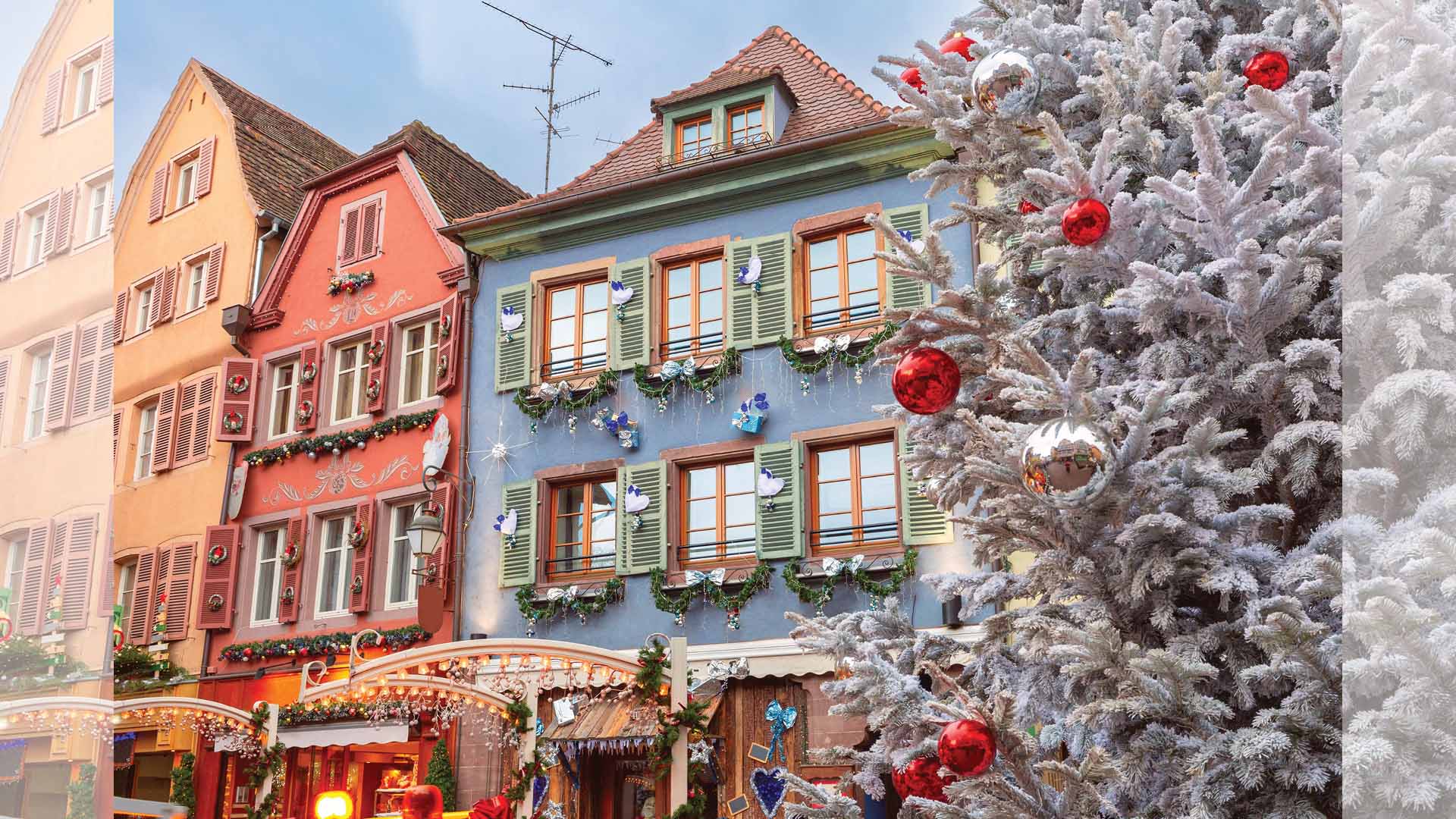|
Listen To Article
|
Europe’s great Advent cities shine brightest when access meets atmosphere — when the experience is not just festive, but finely orchestrated. Picture this: a candle-lit corner held at a beloved brasserie while the crowds drift outside; a licensed guide who knows which chocolatier hand-tempers their truffles and which stallholder saves the best vin chaud for returning patrons.
This feature explores four of Europe’s most iconic Christmas market cities — Strasbourg, Vienna, Copenhagen (Tivoli), and Colmar — through the lens of discreet, insider luxury. Expect precise season windows, smart timings, and curated touches: early-entry tastings before the gates open, golden-hour walks without the frenzy, hands-free shopping via concierge drop, and sensory-led explorations that turn a simple stroll into a story.
Dates to note: Strasbourg (Nov 26–Dec 24), Vienna’s Rathausplatz (Nov 14–Dec 26; Ice World through Jan 6), Tivoli Gardens (Nov 14–Jan 4), and Colmar (open through Dec 29).
1. Strasbourg, Capital of Christmas
Why it matters: In Strasbourg, Christmas is not an event — it is an atmosphere. A presence. The city’s half-timbered heart glows with such warmth and detail that it feels almost theatrical, except it’s not staged. It’s Strasbourg — the archetype of the European Christmas market, and the one others quietly imitate. (November 26 – December 24)
For nearly five centuries, the Alsatian capital has transformed each winter into a living Advent calendar, with every lane flickering in amber light and cinnamon spice. Place de la Cathédrale glows beneath the rose-hued spire, while the towering fir at Place Kléber stands sentinel over a market network so vast it spills into eleven distinct squares.
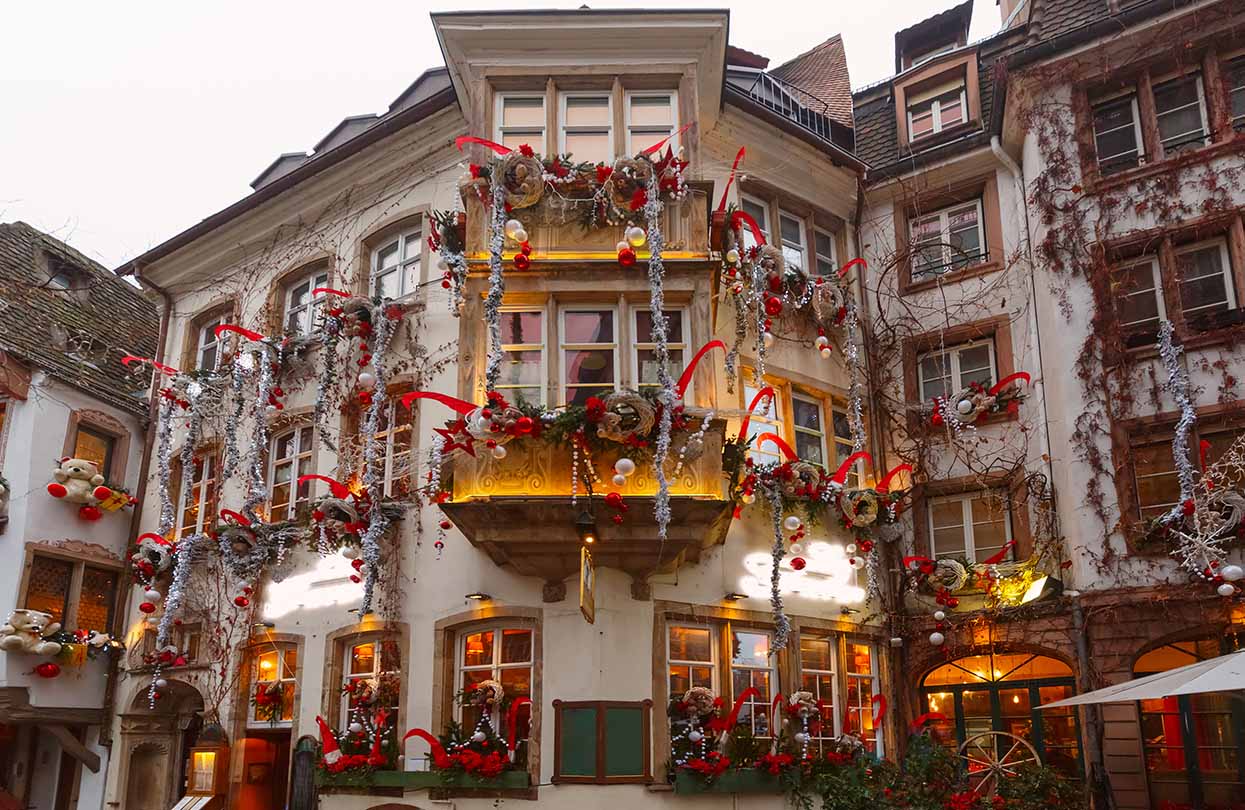
Traditional Alsatian half-timbered house in old town of Strasbourg, image by Kavalenkava, Shutterstock
How to Do It, Discreetly
Start before the crowds. A pre-opening walk with a licensed local guide gives you rare access to Strasbourg’s soul at its quietest — just as stallholders are setting out fresh bredele, mulled wine is beginning to simmer, and the light slants soft across the cobbles. Some VIP guides offer early tastings directly at source: spice breads, candied orange peel, or kirsch-laced confections served before a single queue forms.
At dusk, elevate — literally. With a private sunset slot atop the cathedral platform, you’ll watch the city’s market squares flicker to life beneath you like constellations. It’s an architectural spectacle few get to witness in solitude.
For serious shoppers, arrange hands-free parcel transfers from select chalets straight to your hotel. The Strasbourg concierge network allows you to move lightly through the markets while your parcels take another route entirely — insulated, secure, and waiting when you return.
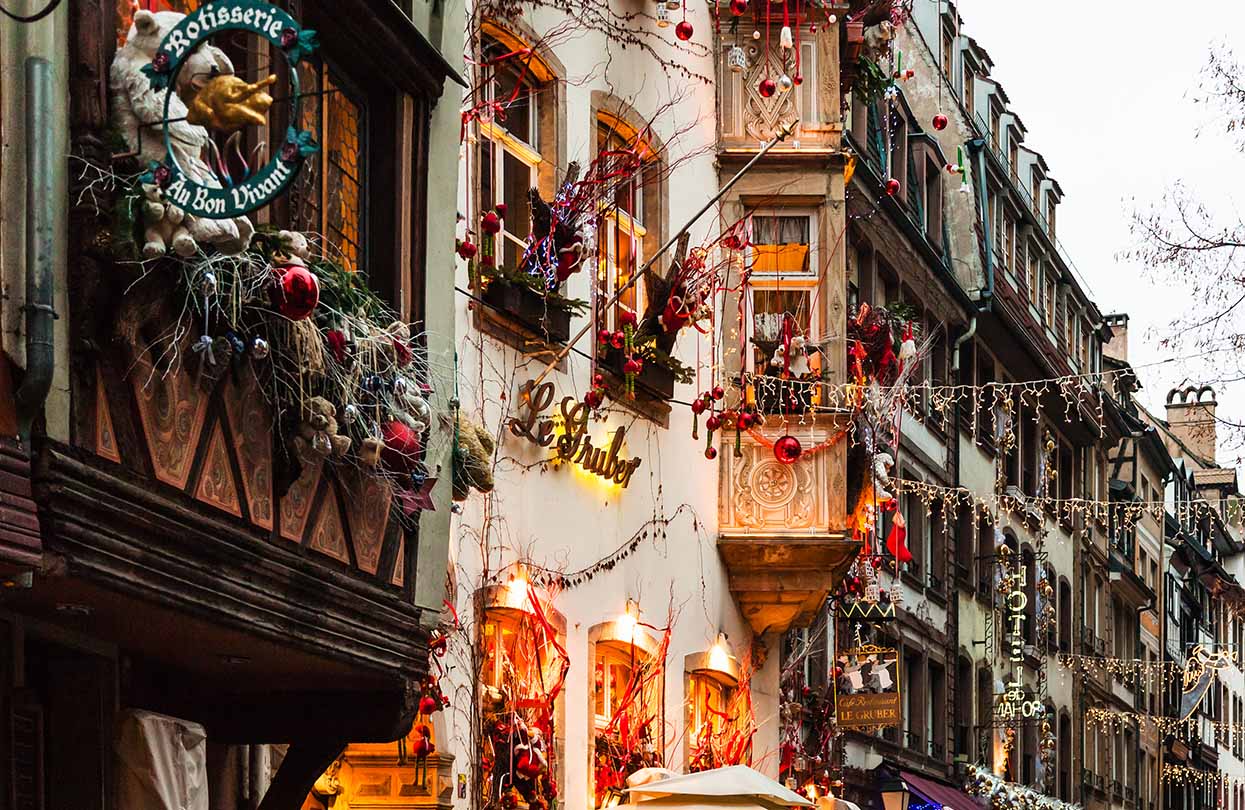
Strassbourg Christmas market is very first Xmas market in France, image by Vvoe, Shutterstock
Eat, Drink, and Linger Well
After twilight, settle into a window-side table at a traditional winstub like Maison des Tanneurs, where the warmth is as immediate as the choucroute. In the storybook quarter of Petite France, cap off your evening with a flight of Alsatian dessert wines — perhaps a Muscat or late-harvest Gewürztraminer — or sample bean-to-bar chocolate pairings guided by local chocolatiers.
For oenophiles, a sommelier-led cellar tasting beneath the old town brings gravitas to the sweetness of the season: structured Rieslings, mineral-laced Pinot Blancs, and stories of sunlit slopes in nearby vineyards.
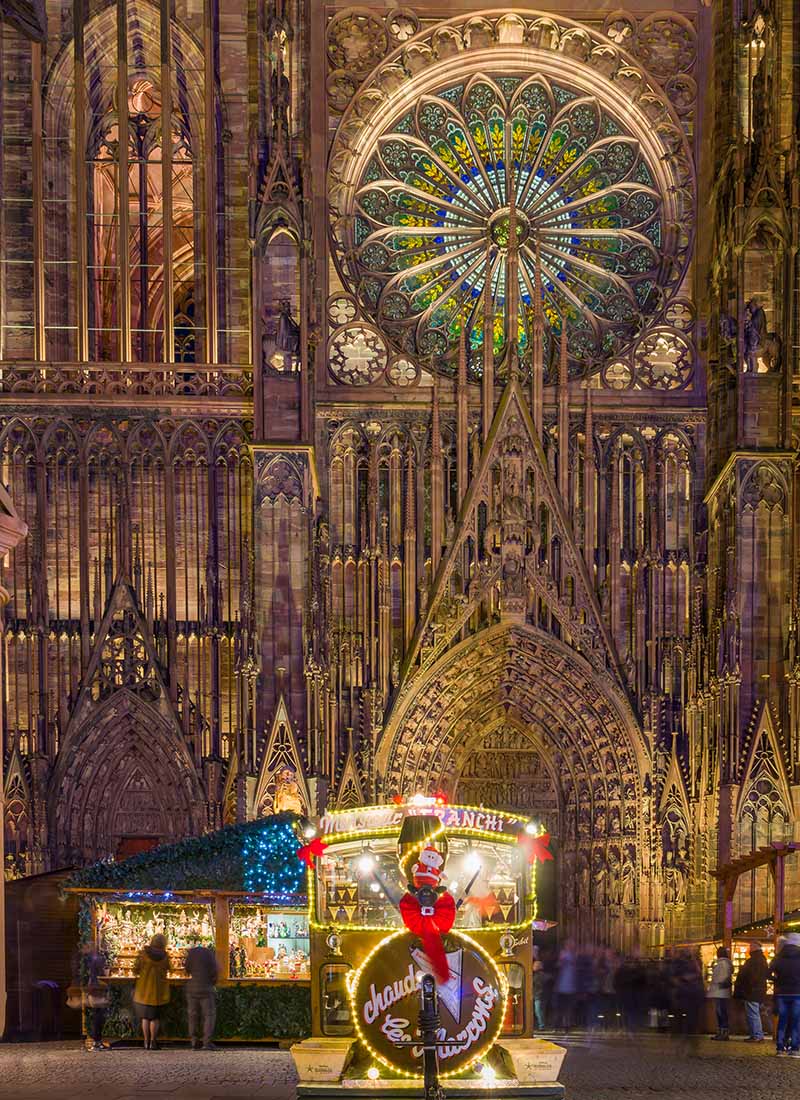
Christkindlmarkt at the Cathedrale in the city of Strasbourg, image by Netfalls Remy Musser, Shutterstock
Stay nearby
Choose a hotel such as Sofitel Strasbourg Grande Île, Strasbourg’s UNESCO-listed core. Opt for river or cathedral-spire views and clawfoot bathtubs — ideal for warming up after long walks through lantern-lit lanes. Foot access is everything; the rest will take care of itself.
2. Vienna’s Rathausplatz & Schönbrunn
Why it matters: Vienna marries market romance with cultural gravitas. Waltzes drift from rehearsal halls, orchestras tune beneath gilt ceilings, and imperial façades provide a stage for Advent’s glow. The Rathausplatz Christkindlmarkt delivers spectacle—an illuminated neo-Gothic backdrop, towering tree, and an avenue of artisan huts—while Schönbrunn Palace adds a more intimate, courtly mood: baroque symmetry, chamber-scale music, and a crafts market that feels curated rather than crowded.
How to Do It, Discreetly
Early light, then waltz: Begin with a professional photo hour at first light, when Rathausplatz is hushed and the city filters gold through winter haze. A nearby studio or private salon can follow with a one-to-one waltz lesson—a graceful reset before you step back into the market. Seal it with heisse Punsch from a favourite hut recommended by your guide.
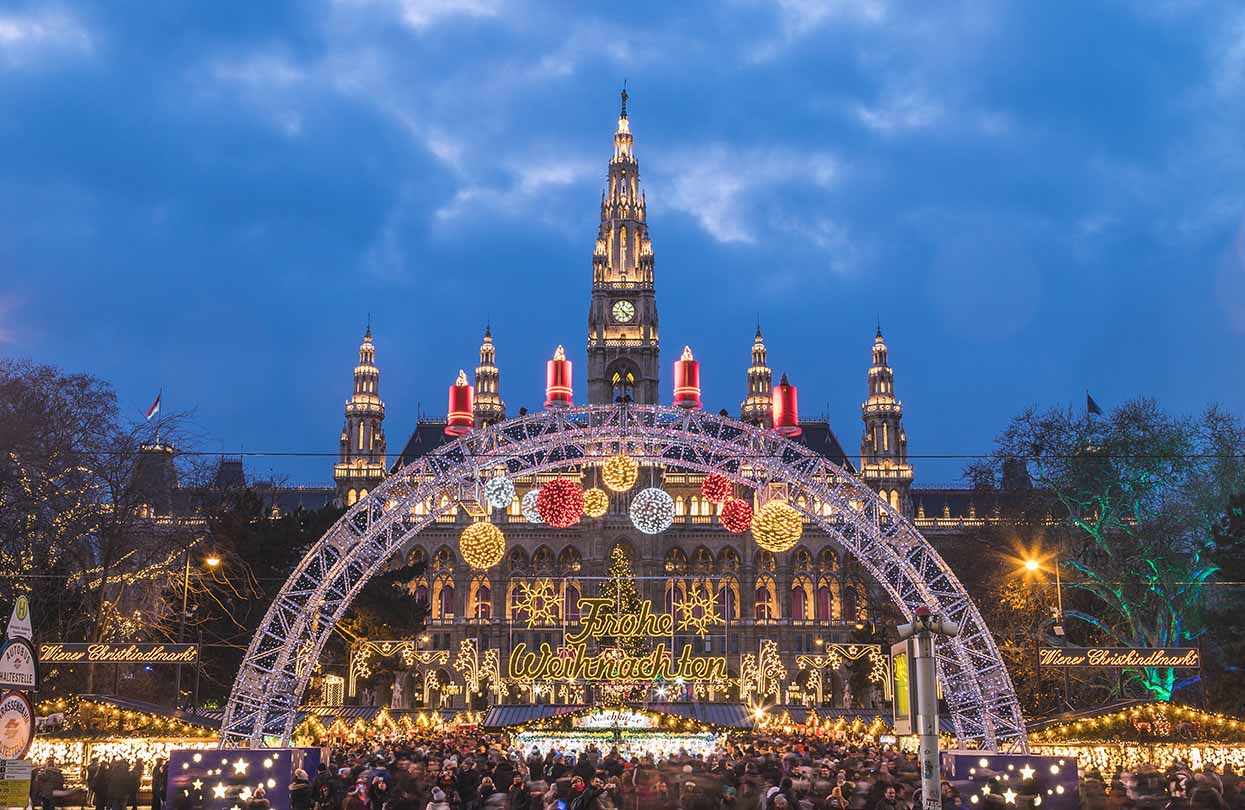
Christmas Market at Rathaus in Vienna, image by Mikecphoto, Shutterstock
Schönbrunn like an insider: Time palace entry to align with the crafts market outdoors. A discreet guide will thread you through back courtyards and quieter stairwells, turning a blockbuster monument into a salon—porcelain, glasswork, and woodcarving viewed at human scale, then a pause for roasted chestnuts beneath the façades that once framed Habsburg winters.
Skate & sip: As Rathausplatz transforms into Vienna’s winter ice world, reserve a rink-front table for hot-chocolate service (or spiked orange punch) and unhurried people-watching. Think gliding silhouettes, brass quintets, and the city’s effortless choreography in real time.
Eat, Drink, and Linger Well
Graduate from market fare to serious Viennese dining without losing the season’s flavour. A grand café delivers ritual—silver trays, whipped cream peaks, and layered tortes—while a modern dining room might present a tasting menu that reinterprets Advent spices with restraint: venison touched with cinnamon smoke, quince sharpened with verjus, poppy and vanilla reframed as textures rather than sweetness. After dark, trade formality for intimacy: a small-church concert where strings glow in candlelight, or a closed-door orchestra rehearsal preview arranged through a concierge—same city, different frequency.
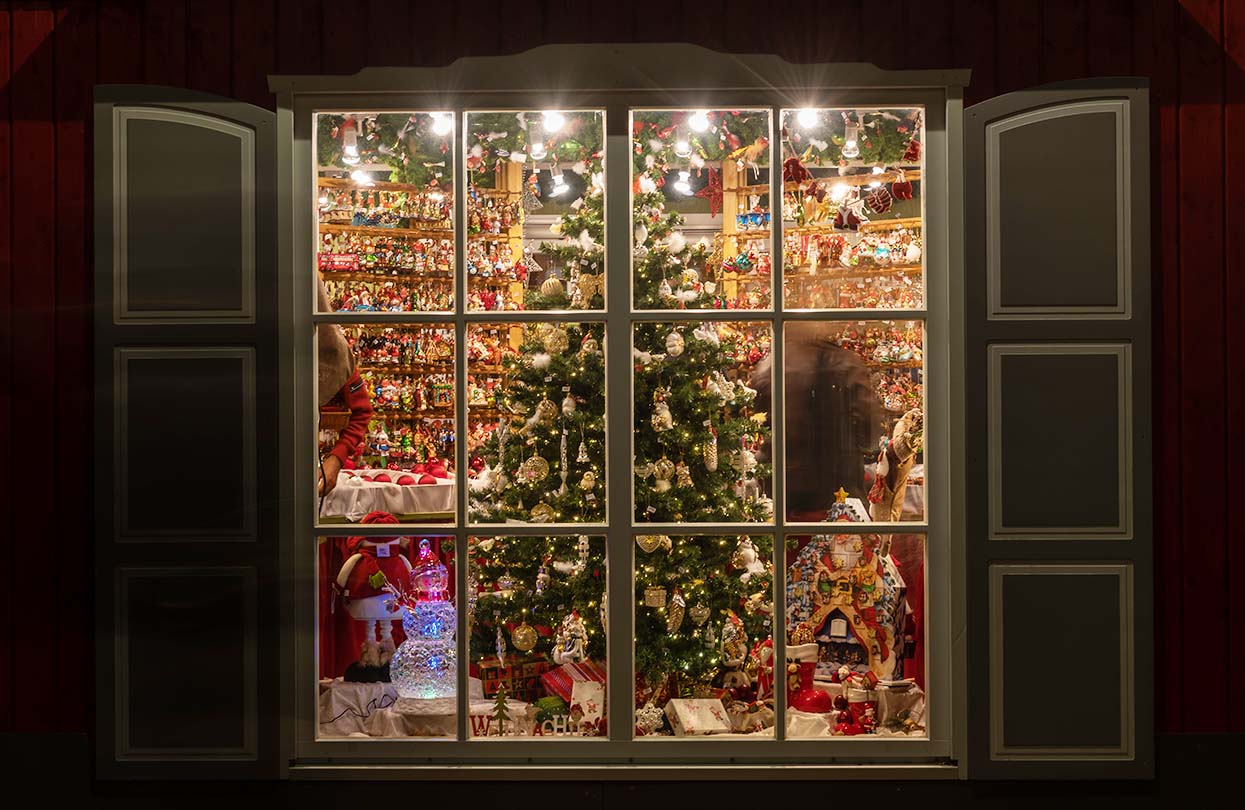
Kiel Christmas Market in the evening festive atmosphere on the Rathausplatz, image by Penofoto, Shutterstock
Stay nearby
Choose a palace-level hotel such as Anantara Palais Hansen Vienna Hotel within an easy walk of the Ringstraße. Corner junior suites offer sweep and silence; double-glazed windows keep the carriage bells and choir notes at a cinematic distance. A butler handles hands-free parcels, last-minute concert tickets, and warm-up cocoa on return. You move through Advent lightly: morning portraits, mid-day palace craft, twilight skating, and late-night strings—each moment threaded together so the city feels less like a checklist, more like a private engagement.
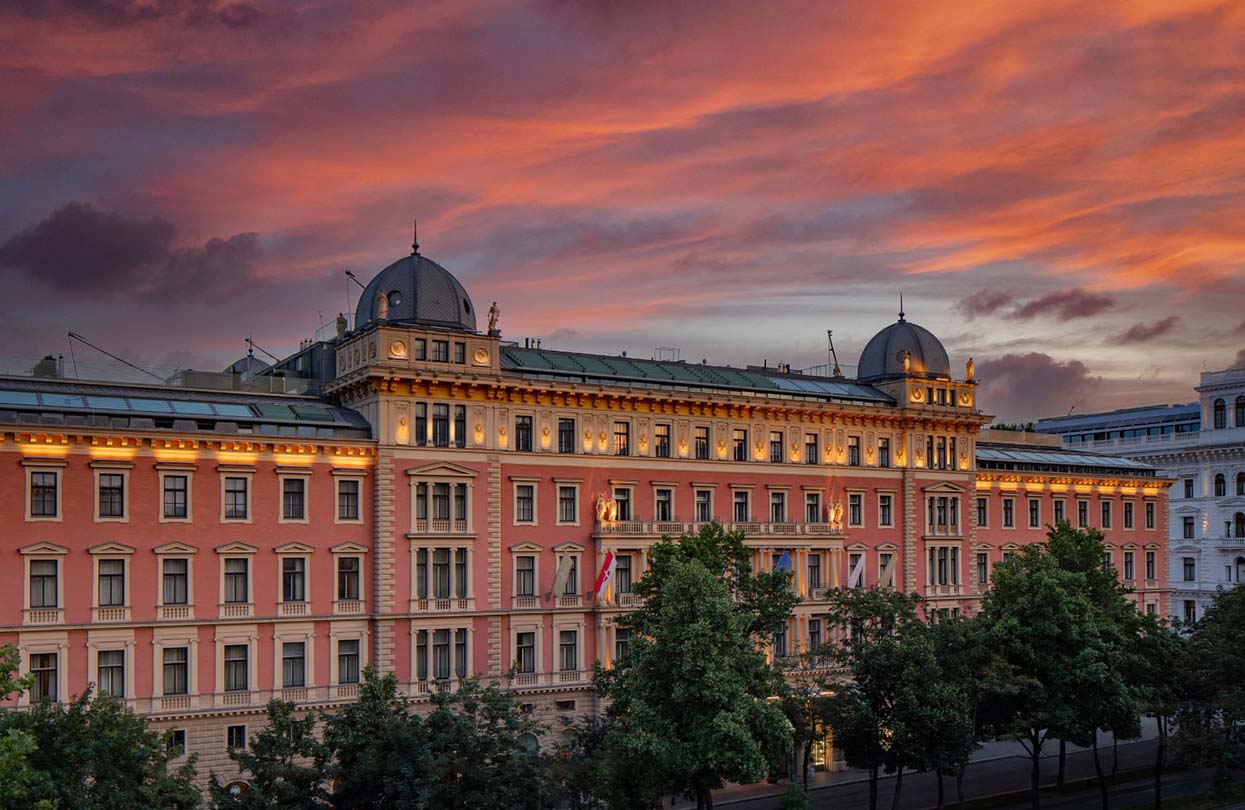
Anantara Palais Hansen Vienna
Vienna’s secret is poise. Between Rathausplatz’s grandeur and Schönbrunn’s intimacy, the Advent season reads not as spectacle but as conversation—between gilded rooms, winter air, and the quiet thrill of being exactly where tradition still breathes. (Season: Nov 14 – Dec 26 (Rathausplatz); Schönbrunn: Nov 6 – Jan 6)
3. Copenhagen: Christmas in Tivoli
Why it matters: Tivoli Gardens is Copenhagen’s winter fairy tale made real — a 19th-century pleasure park reimagined for Advent with Nordic restraint and cinematic charm. Lantern-lit alleys thread past spruce-draped pavilions; boutiques glow with wool, wood and glass; carousels turn beneath constellations of light. It is joyful, impeccably curated, and effortlessly photogenic — a place where design sense and nostalgia meet in perfect proportion.
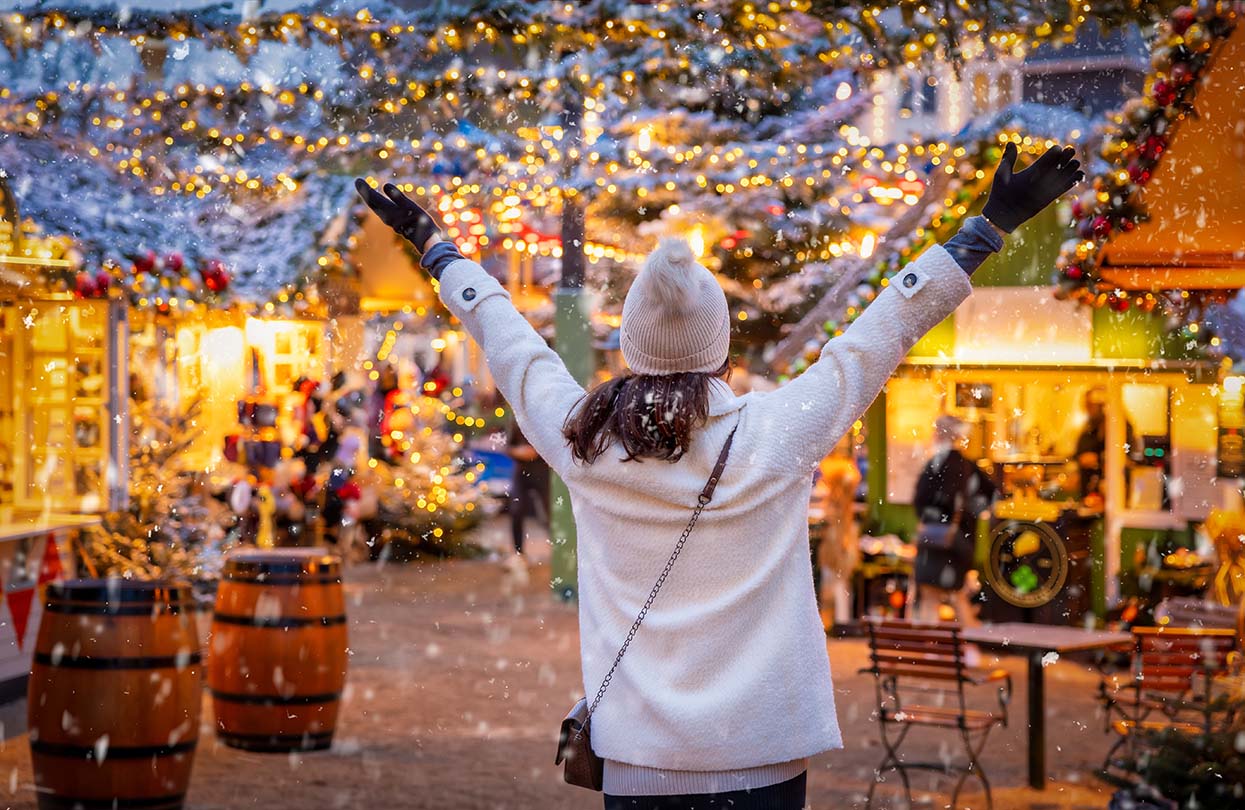
Christmas market in Copenhagen, image by Sven Hansche, Shutterstock
How to Do It, Discreetly
Skip-line wristbands & reserved dinner: Glide past queues with pre-arranged access, then take your time over a classic feast at Grøften — red-checked tablecloths, brass, and time-honoured plates — or step inside Nimb for a more polished interpretation of winter comfort. With the table secured, the park unfolds at your rhythm: rides when the crowds swell elsewhere, a nightcap when the lights peak.
Backstage light-show peek: On select dates, arrange a technical walkthrough with a lighting specialist. Seeing the choreography behind Tivoli’s illuminations — gels, gobos, pixel mapping, timing — reframes the spectacle as craft. It’s a privileged, surprisingly intimate angle on what most only view from the promenade.
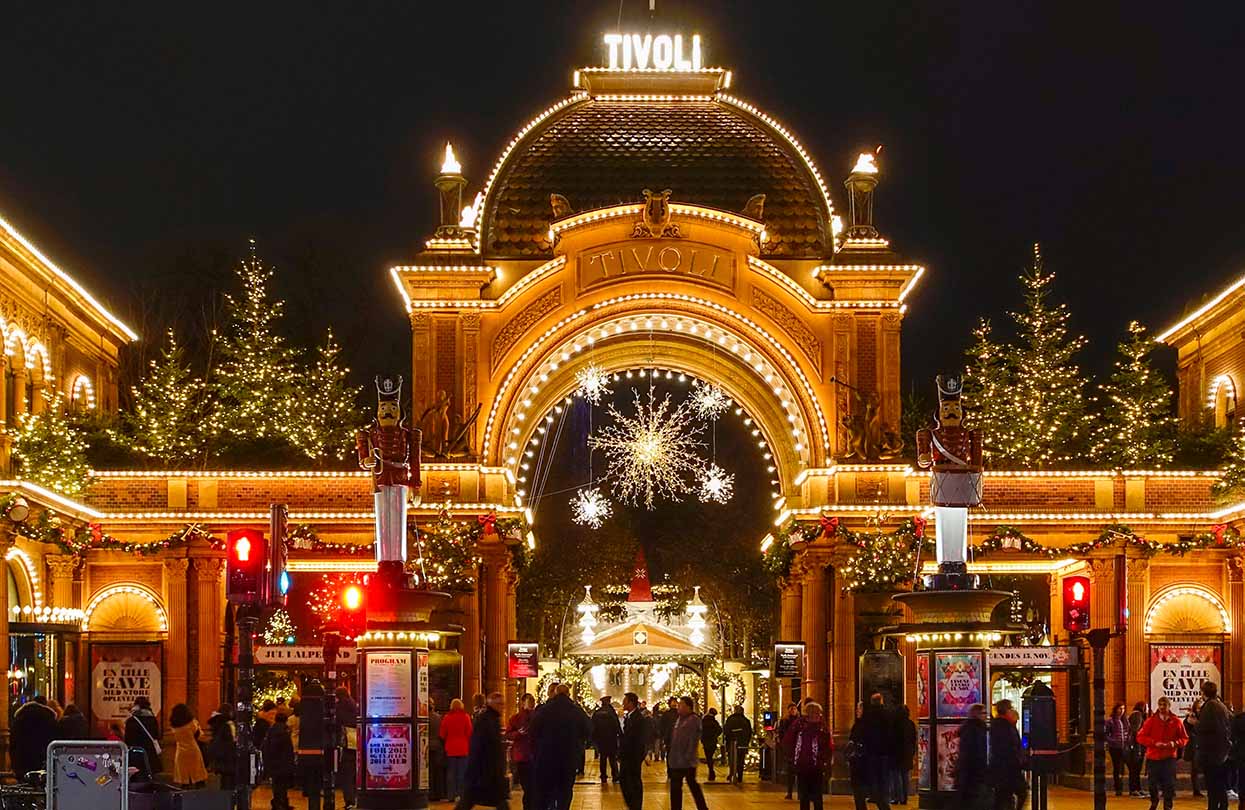
Tivoli with Christmas decoration, Copenhagen, image by Footageclips, Shutterstock
Private skating lesson: Book the first slot of the morning for untouched ice, clean edges and crisp photos. A private coach will tune the session to your level — from balance drills to elegant turns — while a photographer captures the quiet before the day begins.
Eat, Drink, and Linger Well
Tivoli’s dining runs a considered gamut from nostalgic to New-Nordic. Make it a progressive dinner: begin with gløgg (mulled wine perfumed with cardamom and orange) and æbleskiver (doughnut-soft pancake spheres dusted with sugar), then shift to seafood — perhaps lightly cured salmon, dill and rye — before a late dessert bar as the park settles. Between courses, pause for a ride or slip into a pavilion for a hot chocolate layered with cream. Coffee is serious; pastries are precise. And if the evening leans celebratory, Nimb’s bars handle Champagne with the same grace as aquavit.
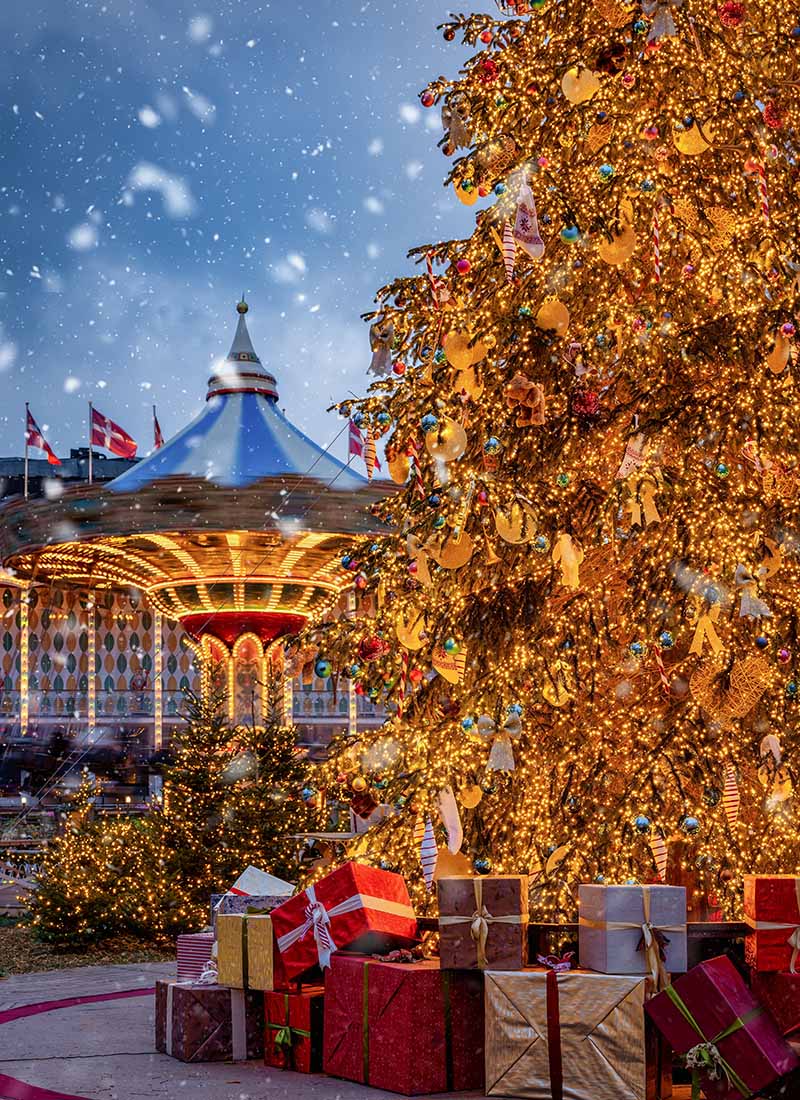
Christmas in Copenhagen, Tivoli Gardens, Image by Sven Hansche, Shutterstock
Stay nearby
Choose design-forward suites at Nimb Hotel, an SLH Hotel facing Tivoli so you can drift in and out through the day — rides and shopping between spa time and fireside pauses. Floor-to-ceiling windows frame the gardens like a living snow globe; double glazing keeps the music atmospheric, not intrusive. Concierge teams manage timed entries and last-minute seatings, so your footprint stays light and the experience frictionless.
Tivoli at Christmas is Copenhagen distilled: considered, cosy, quietly exacting. Do it with access and intention, and the park becomes less a theme destination than a winter salon — a place to stroll, savour and be gently, beautifully delighted. (Season: Nov 14 – Jan 4)
4. Colmar’s Six Market Squares
Why it matters: Colmar is compact, curated, and crucially open beyond Christmas — a gift for travellers who prefer late-December calm to peak-season crush when in France. Half-timbered houses tilt toward mirror-still canals, façades garlanded in fir and white ribbon; six distinct market squares — from Place des Dominicains to Petite Venise — each carry a different mood: sacred glow, riverside romance, artisanal focus, children’s wonder. Stalls are vetted with Alsatian rigor, chocolate is a civic pride, and the town’s scale means everything is walkable without compromise: no rush, no detours, just light, scent, and sound arranged with purpose.
How to Do It, Discreetly
Private canal boat at dusk: Slip along Petite Venise as lanterns lift and windows bloom with candlelight. A blanket across the knees, vin chaud in hand — reflections double the garlands and the timbered eaves, turning the old town into a moving mise-en-scène. Photographers prize the blue-hour glide; so will collectors of quiet.
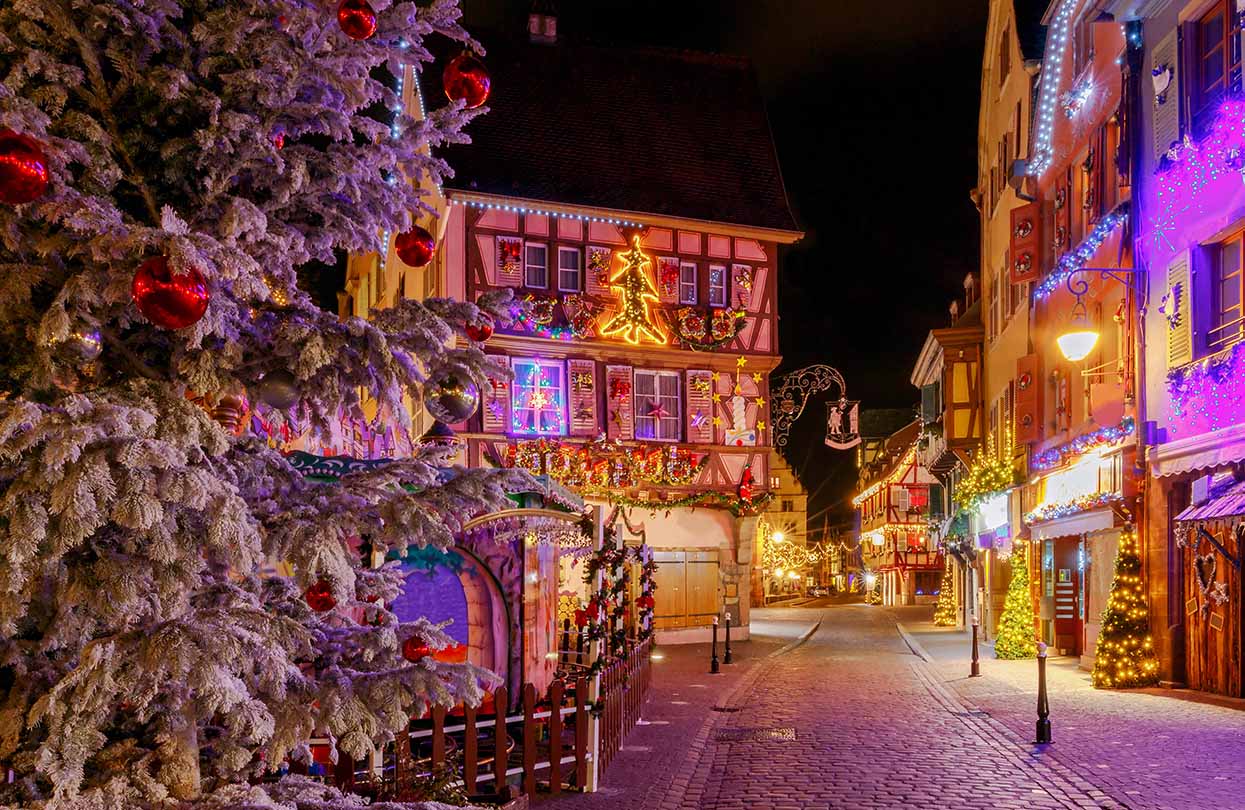
Colmar on Christmas Eve, Image by Kavalenkau, Shutterstock
Chocolate & foie gras trail: A guided amble threads a small, serious roster of artisans — bean-to-bar chocolatiers working precise temper lines and single-origin pralines; a foie gras atelier serving torchon with quince or late-harvest Gewürztraminer gel. Tastings are paired rather than piled: two or three signatures at each stop so flavours remain legible. Expect notes on cocoa terroir (Madagascar brightness vs. Venezuelan depth) and on duck vs. goose texture — the sort of detail that lingers into January.
After-hours cellar tasting: When the squares thin, a family winemaker unlocks an old stone cellar for private pours — Riesling with mineral cut, Pinot Gris with orchard weight, Vendanges Tardives and Sélection de Grains Nobles that read like silk. Bring market cheeses and a still-warm loaf; the tasting becomes a late supper under ribbed vaults, candlelight catching the bottles’ antique glass.
Eat, Drink, and Linger Well
Alsace excels at indulgence paced by strollability. Book one grand dinner — perhaps in a timbered winstub where choucroute arrives fragrant with juniper and a flaky tarte flambée comes blistered from the oven — then keep the rest deliberately spontaneous. The finest nights unfold under fairy-lit eaves: a stand for bredele (anise, cinnamon, hazelnut), another for flammekueche folded to go, a final pause for hot chocolate whipped to a satin gloss. If the evening asks for structure, a sommelier-led flight at a vaulted bar restores it: dry Rieslings to reset the palate, a late-harvest pour to close the loop.

Colmar on Christmas Eve, Image by Kavalenkau, Shutterstock
Stay nearby
Choose boutique townhouses and Relais & Châteaux addresses such as La Maison des Têtes inside the old centre so every square sits within a lantern-lit amble. Think fireplaces that take the chill off wool coats, soaking tubs for thawing after-market miles, and concierges who manage hands-free parcels from selected chalets. With everything within minutes, Colmar becomes less an itinerary than a rhythm — six markets, one mood: curated brightness that lasts beyond Christmas. (Season: Nov 25–Dec 29)
Plan Like a Pro
Timing: Aim for mid-week golden hour. Skip late-morning coach waves; arrive early, break for lunch, and return after 5 pm for softer light and thinner crowds.
Logistics: Touch-screen gloves, a slim power bank, and a crossbody keep hands free for tastings and photos.
Family etiquette: Look for quieter Kinderzeit slots; pre-book to keep little ones calm and engaged.
Access & safety: Major cities use security perimeters; a licensed guide accelerates checks, shortcuts queues, and protects your time.
Sustainability: Choose vendors with clear provenance, carry a reusable insulated cup, and consolidate purchases to minimise packaging and deliveries.
What Insiders Book
Strasbourg: Pre-opening market walk with a licensed guide, plus a stallholder tasting of bredele and vin chaud before queues form.
Vienna: Private waltz class near the Ring, then a rink-front table for hot chocolate as the Rathausplatz ice world comes alive.
Copenhagen (Tivoli): Skip-line wristbands, a Nimb dinner held to time, and a first-on-ice coaching slot for pristine photos.
Colmar: Dusk canal boat with blankets and lanterns, followed by an after-hours cellar where your market cheeses become a late supper.
Concierge add-ons: Private choir rehearsal access, artisan craft workshops, and ornament-making sessions tailored for children.
Micro-FAQ
When do Strasbourg’s markets run? Typically from the last week of November to Christmas Eve; always confirm the specific year’s calendar before booking.
Is Tivoli open over New Year? Yes. Christmas in Tivoli usually continues into the first week of January.
Are Vienna’s markets cashless? Many huts accept cards, but keep small change for classics and deposits (mug returns).
Can I skip lines? In parks like Tivoli, yes (skip-line access). In open city squares, rely on licensed guides, routing, and timing.
What should I wear? Waterproof leather boots with grip, a warm wool base, and a pocketable down layer for surprise squalls. ◼
Subscribe to the latest edition now by clicking here.
© This article was first published online in Sept 2025 – World Travel Magazine.

